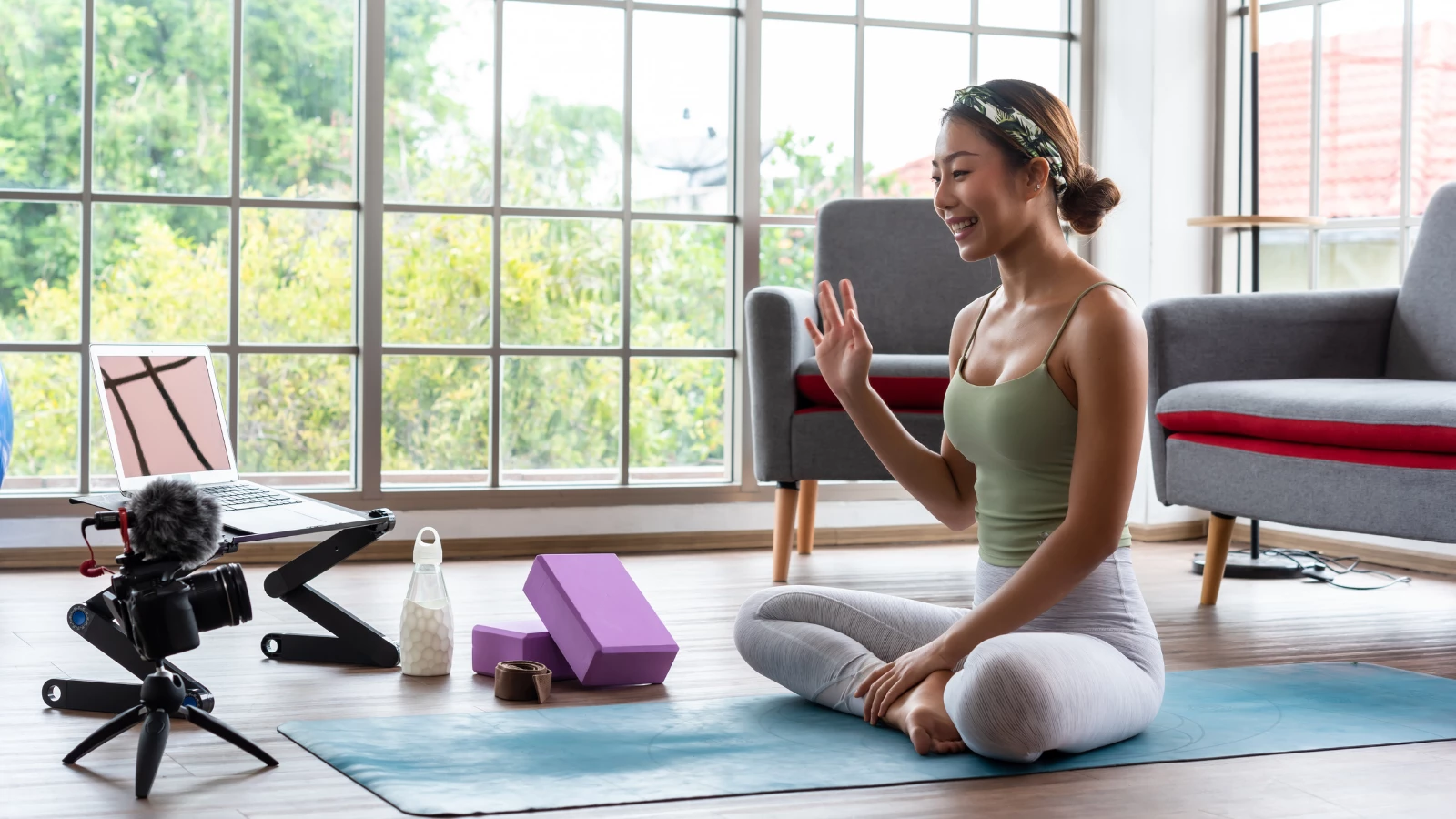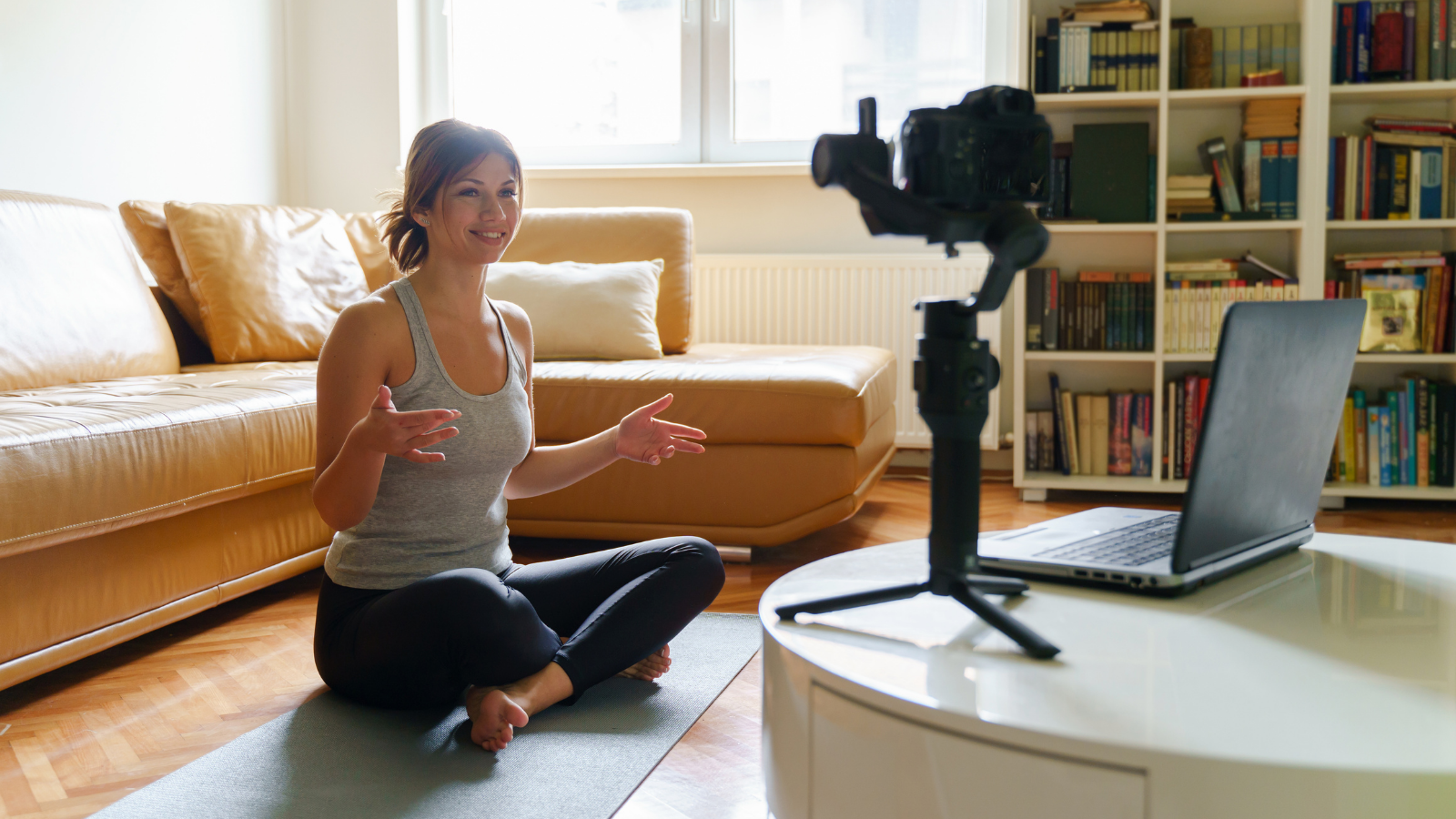How to Teach Yoga Online: 5 Practical Tips

Article At A Glance
When it comes to teaching yoga online, everyone will have different feelings. Some yoga teachers absolutely love to teach yoga online, whereas others absolutely hate it.
Whether you love it or hate it, teaching yoga online is certainly here to stay and it doesn’t look like that is changing anytime soon. So you might as well learn to love it—or at least make peace with it! And if you’re armed with the right tools and tips to do so, you just might find that you actually enjoy teaching yoga online after all.
Here Are 5 Practical Tips for How to Teach Yoga Online
When you teach yoga online, it can sometimes feel intimidating and scary (especially if you’re not a tech wizard), but following these simple tips, it might help to ease some of the extra burdens that online teaching can produce.
1. Invest in Quality Equipment

There’s nothing worse than trying to follow along with an online yoga class when you can’t hear the teacher because they have no mic or you can’t see the poses because the lighting is too dark. How to teach yoga online can be broken down into one simple sentence: invest in quality equipment.
The best online classes always look so professional because they are professionally made! But you don’t have to be a filmmaker to create high-quality content. You just need to know what to use.
So do your research and invest in a good camera that works well in your space. Oftentimes, a smartphone camera can work wonders here! Just make sure that it will allow you to fit your whole mat and body into the scene in various positions (standing, seated, inverted, etc.).
You’ll also want to invest in a high-quality microphone that can work with your camera. Do your research and double-check that the camera and phone are compatible, whether they need to be wired or work wirelessly. It’s always best to use an external microphone whenever possible rather than your camera’s built-in microphone. When teaching yoga, you’re simply too far from the camera for the microphone to pick up all your wonderful cues.
And the last thing people want to miss out on when you teach yoga online is your cues! That’s what they came to hear. So make sure they can hear you loud and clear.
Finally, you may want to invest in some good-quality lighting. Sometimes, natural light can be your best option—so you may just choose to shoot in daylight around lots of windows, or even outdoors. But, you might find that that still doesn’t produce a bright enough environment. So you may wish to purchase some lights (like ring lights, LED lights, etc.) to brighten up your “studio” space.
Just make sure that you can be seen and heard and the rest will fall into place!
2. Test, Test, Test
Technology can be finicky. Sometimes you think you’ve set everything up perfectly. Then you start teaching and get flooded with messages that your audio isn’t on.
When it comes to how to teach yoga online, testing might be your number one priority. Before any Zoom session, or when you’re about to create a pre-recorded video, just be sure to run a few diagnostic tests to make sure that everything is running smoothly.
Again, can you be seen? And can you be heard? These are the primary concerns. If your tests run smoothly, then it’s much more likely that your actual classes will also run smoothly.
3. Prepare Extra
Of course, no matter how much you test, something will inevitably always go wrong with technology or anything else.
Whether it’s a congested network or an uninvited Zoom participant or your cat just plopping down on your mat and refusing to move, teaching yoga online comes with its own set of unexpected interruptions.
This is why you’ll want to be more prepared than ever so that when all the little (or big!) hiccups occur, they don’t throw you off from teaching the best class ever. You’ll want to be so prepared and so invested in your teaching that nothing can distract you or make you lose your cool.
And nothing helps you keep your cool more than being infallibly prepared. So whether you draw out your sequences in stick figures or write everything down in Sanskrit, just make sure that you know exactly what’s coming next so you never have to worry about your plan while you’re busy worrying about how the heck to move your sweet little kitty.
4. Connect With Your Online Students

A huge criticism of all online media, in general, is that it creates a false sense of connection but an actual greater sense of disconnect.
Obviously, you don’t want your online yoga classes to feel that way at all. So make a concerted effort to connect with your online students.
Ask them to turn their cameras on so you can observe their practices and offer comments about how to improve their alignment or activation skills. Speak to them before or after class just as you would at an in-person event. Have a sense of humor to break any tension. Allow yourself to show your own flaws in your practice so your students can feel connected to you. Offer many different options for every pose so everyone feels welcome in your practices.
In whatever unique way you connect with your students in person, do the same when you teach online. Don’t allow the screen to become a barrier to your connection with your students.
5. Be Yourself
Your students are showing up to practice with you online because they already love you. And switching to an online platform isn’t easy for anyone. But your students know that it’s worthwhile because they’ll still get the classes that they know and love from you.
When you teach yoga online, continue to be your lovable, wonderful self. Sometimes, especially if we’re nervous about using new technologies or teaching through new platforms, we might put on a “teacher voice” or try to impress new students by showing up with fancy poses.
But there’s no need to be anyone but the teacher that you already are when you teach yoga online. So continue to offer the same amazing classes that you offer in-person—just now accessible to a wider audience.
And if you continue to be the wonderful teacher that you already are, you’ll see students flock to your online classes in droves.
Use These Tips for How to Teach Yoga Online Seamlessly
When you change your teaching in any way, it can be scary and overwhelming. But when you make the transition to teaching yoga online, it doesn’t have to be such a terrifying process, if you know the proper steps to take to make it work seamlessly.
Try these practical tips for how to teach yoga online and you just might be surprised by how seamless the transition can be!
Also, read...
The Fire Element: Enlighten Up!
Yogic Breathing for Better Lung Capacity
Supported Shoulderstand: Yoga Inversion Practice for Almost Everybody
Related courses
Yoga and Myofascial Release: Releasing Chronic Tension with the Bodymind Ballwork Method
Yoga and Detoxification: Tips for Stimulating Lymphatic Health

Leah Sugerman is a yoga teacher, writer, and passionate world traveler. An eternally grateful student, she has trained in countless schools and traditions of the practice. She teaches a fusion of the styles she has studied with a strong emphasis on breath, alignment, and anatomical integrity. Leah teaches workshops, retreats, and trainings, both internationally and online. For more information, visit www.leahsugerman.com.




